As a materials consultant with years of experience guiding manufacturers through the complexities of polymer selection, I’ve fielded countless questions about TPR (Thermoplastic Rubber) and its performance in various applications. One concern that comes up often, especially from designers and product developers, is whether TPR is prone to deformation. It’s a valid worry—nobody wants their product to lose shape or fail under normal use. Having worked on projects ranging from footwear to consumer electronics, I’ve seen TPR shine in some cases and struggle in others. In this article, I’ll explore the factors that affect TPR’s deformation, share practical insights from my work, and provide tips to ensure it performs reliably in your projects. Let’s get to the bottom of this and help you make informed decisions.

Understanding TPR and Deformation Concerns
TPR is a popular choice in industries I’ve consulted for because it combines the flexibility of rubber with the processability of plastics. Its soft, stretchy nature makes it ideal for products like shoe soles, grips, and seals, but this same flexibility can raise questions about its ability to hold shape under stress, heat, or prolonged use. In my experience, whether TPR deforms easily depends on its formulation, application, and environmental conditions. To address this, I’ll break down what TPR is, why deformation might occur, and how to prevent it, drawing from real-world projects I’ve tackled.
What Is TPR?
Before diving into deformation, let’s clarify what TPR is. Thermoplastic Rubber is a type of thermoplastic elastomer (TPE), known for its ability to stretch and return to its original shape. Here’s a quick overview based on my work with the material:
Composition: TPR is typically made from styrene-butadiene-styrene (SBS) or styrene-ethylene-butylene-styrene (SEBS), blended with additives like oils, fillers, or stabilizers to tweak its properties.
Properties: TPR is soft, elastic, and recyclable, with a rubber-like feel. It offers good impact resistance but has moderate heat resistance (softens above 80-100°C) and limited chemical resistance.
Processing: TPR can be injection-molded, extruded, or blow-molded without curing, making it cost-effective for mass production.
Applications: I’ve seen TPR used in shoe soles, tool handles, toys, phone cases, and medical tubing due to its flexibility and affordability.
For example, I once helped a company design a line of budget-friendly fitness bands using TPR because it was stretchy, comfortable, and easy to mold. But deformation concerns arose when users left the bands in hot cars, prompting a deeper look into TPR’s limitations.

Does TPR Deform Easily?
The short answer is: it depends. TPR can resist deformation well under the right conditions, but it’s not immune to losing shape if misused or exposed to stressors like heat, pressure, or chemicals. Here’s what I’ve learned from my projects about when and why TPR might deform:
Heat Exposure:
TPR is thermoplastic, meaning it softens when heated. Above 80-100°C, it can lose shape, especially under load. I’ve seen TPR shoe soles deform when left near heaters or in hot environments.
Deformation is more likely with SBS-based TPR, which has lower heat resistance than SEBS-based TPR.
Prolonged Stress:
If TPR is stretched or compressed for long periods, it may develop creep (permanent deformation). For instance, a TPR seal under constant pressure might flatten over time.
This is more common in soft, low-durometer TPR formulations (e.g., Shore A 30-50).
Chemical Exposure:
TPR has limited resistance to oils, solvents, or UV light, which can degrade its structure and lead to deformation. I’ve seen TPR grips on outdoor tools warp after exposure to gasoline or prolonged sunlight.
Overloading:
Applying excessive force beyond TPR’s tensile strength can cause tearing or stretching. This happened in a project where TPR was used for a heavy-duty strap that was overstretched.
In my experience, TPR doesn’t deform easily in mild conditions (e.g., room temperature, moderate stress), but it’s not as robust as materials like polyurethane or silicone in harsh environments.

Factors Affecting TPR’s Deformation
To understand why TPR might deform in some cases and not others, let’s look at the key factors I consider when advising clients:
Formulation: The choice of SBS vs. SEBS, along with additives like UV stabilizers or reinforcing fillers, impacts deformation resistance. SEBS-based TPR is more durable and heat-resistant.
Hardness: Measured on the Shore A scale, softer TPR (e.g., 30A) is more prone to deformation than harder grades (e.g., 80A). I’ve specified harder TPR for applications needing shape retention.
Design: Thin or poorly supported TPR parts are more likely to deform. For example, a thin TPR sole might buckle under heavy weight.
Environment: Heat, UV exposure, or chemicals accelerate deformation. Indoor applications (e.g., phone cases) fare better than outdoor ones (e.g., garden hose seals).
Usage: TPR under constant stress (e.g., compressed seals) or cyclic loading (e.g., shoe soles) may deform over time if not properly formulated.
In one project, a client’s TPR yoga mat deformed under hot studio conditions. Switching to a SEBS-based TPR with heat stabilizers solved the issue, showing how formulation can make a big difference.

Comparison Table: TPR’s Deformation vs. Other Materials
To put TPR’s deformation tendencies in perspective, here’s a table comparing it to other common materials I’ve worked with:
| Material | Deformation Risk | Heat Resistance | Best Use |
|---|---|---|---|
| TPR | Moderate (softens above 80-100°C) | Up to 80-100°C | Budget-friendly, flexible products |
| Polyurethane (TPU) | Low (resists up to 120-150°C) | Up to 120-150°C | High-wear, durable applications |
| Silicone | Very low (stable up to 200°C) | Up to 200-250°C | High-heat, medical-grade uses |
| Natural Rubber | Moderate (vulcanized, varies) | Up to 70-100°C | Tires, heavy-duty elastic parts |
How to Prevent TPR Deformation
Based on my experience, here are practical strategies to minimize TPR deformation in your products:
Choose the Right Formulation:
Opt for SEBS-based TPR for better heat and UV resistance.
Use additives like UV stabilizers for outdoor applications or fillers for increased stiffness. I’ve specified reinforced TPR for outdoor grips to prevent warping.
Select Appropriate Hardness:
Use harder TPR grades (e.g., Shore A 60-80) for parts needing shape retention, like seals or soles.
Softer grades (e.g., Shore A 30-50) are fine for grips or bands but may deform under load.
Optimize Product Design:
Avoid thin sections or unsupported structures that can buckle. For example, I redesigned a TPR sole with thicker support to reduce deformation.
Incorporate ribs or reinforcements to enhance structural integrity.

Control Environmental Exposure:
Keep TPR products away from high heat (e.g., ovens, car dashboards) or direct sunlight.
Protect against chemicals like oils or solvents, which can soften TPR.
Test Under Real Conditions:
Prototype your product and test it in its intended environment. I always recommend accelerated aging tests (e.g., heat, UV, or stress exposure) to predict deformation.
Work with suppliers to get material data sheets and samples for testing.
In a project for a pet toy manufacturer, we reduced deformation in TPR chew toys by using a harder SEBS-based TPR and adding UV stabilizers, ensuring the toys held up during outdoor play.
My Experience: Tackling TPR Deformation
A couple of years ago, I worked with a company making TPR phone cases. Customers complained that the cases stretched out after months of use, especially in warm climates. After reviewing their formulation, I found they were using a soft, SBS-based TPR with no heat stabilizers. We switched to a SEBS-based TPR with a higher Shore A hardness (60A) and added UV stabilizers. The new cases retained their shape even in hot conditions, and customer complaints dropped significantly. This experience taught me that TPR can perform well if tailored to the application, but it requires careful selection and testing.
In another case, a client used TPR for a garden hose seal, which deformed under constant water pressure. We replaced it with silicone for better heat and compression resistance, as TPR wasn’t suited for that level of stress. These projects highlight the importance of matching TPR to its intended use.

When to Use TPR vs. Alternatives
To decide whether TPR is the right material or if its deformation risk is too high, here’s how I approach material selection:
Use TPR When:
You need a cost-effective, flexible material for indoor or mild conditions (e.g., phone cases, grips, budget shoe soles).
Recyclability and easy processing are priorities. I recommended TPR for a company making reusable straws due to its low cost and eco-friendliness.
The product won’t face high heat (above 80°C) or constant stress.
Choose Alternatives When:
High Heat: For applications like oven seals or hot environments, silicone or fluorocarbon elastomers are better.
Heavy Wear: Polyurethane (TPU) outperforms TPR in sports shoes or conveyor belts due to its abrasion resistance.
Constant Stress: For seals or gaskets under pressure, EPDM or nitrile rubber resist deformation better.
Chemical Exposure: Polyurethane or viton handle oils or solvents better than TPR.
For a client making outdoor fitness equipment, I switched from TPR to TPU for handle grips to avoid deformation in sunlight, proving that TPR isn’t always the best fit.
Maintenance Tips to Reduce TPR Deformation
To keep TPR products in shape, follow these tips from my work with manufacturers:
Avoid Heat: Store TPR items away from radiators, car interiors, or direct sunlight to prevent softening.
Clean Gently: Use a damp cloth with mild soap; avoid solvents or abrasive cleaners that can degrade TPR.
Limit Stress: Don’t leave TPR under constant tension or compression (e.g., tightly stretched bands).
Inspect Regularly: Check for cracks, softening, or shape loss, especially in outdoor or high-use products.

A Personal Story: Saving a Product Line
Last year, I was called in by a small business producing TPR water bottle grips. Users reported that the grips deformed after being left in gym bags during hot summer days. The company was worried about losing their market. After analyzing their SBS-based TPR, I suggested switching to a SEBS-based TPR with a higher melting point and UV stabilizers. We also thickened the grip design to reduce stress points. The new grips held their shape, even in heat, and the business saw a surge in positive reviews. This experience reminded me how a few tweaks in material and design can turn a potential failure into a success.
Conclusion: TPR Can Resist Deformation with the Right Approach
To wrap up, TPR doesn’t deform easily in mild conditions, but its thermoplastic nature makes it susceptible to heat, prolonged stress, chemicals, or poor design. By choosing SEBS-based TPR, harder grades, and optimized designs, and by controlling environmental exposure, you can minimize deformation risks. If your application involves high heat, heavy wear, or constant stress, alternatives like polyurethane or silicone may be better. With the insights and tips I’ve shared, you can confidently use TPR where it excels. If you’re facing deformation issues or need help selecting the right material, share your project details in the comments, and I’ll offer tailored advice!
Related Q&A
Q1: Can TPR be made more deformation-resistant?
A: Yes, use SEBS-based TPR, harder grades (e.g., Shore A 60-80), and additives like UV stabilizers or fillers. Optimize design to avoid thin or stressed areas.
Q2: How does TPR compare to silicone for deformation?
A: Silicone resists deformation better, especially at high temperatures (up to 200°C) and under constant stress. TPR is cheaper but less durable in harsh conditions.
Q3: Can deformed TPR be fixed?
A: Once TPR deforms permanently (e.g., due to heat or creep), it can’t be restored. Replace the part or redesign with a more resistant material.
Q4: Is TPR safe for products despite deformation risks?
A: TPR is safe for consumer goods if properly formulated. For food-contact or medical uses, ensure it’s FDA-compliant. Deformation doesn’t affect safety but may impact functionality.





